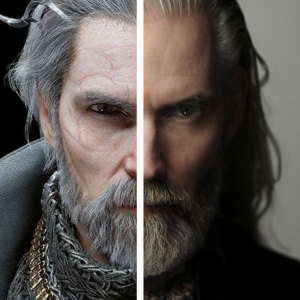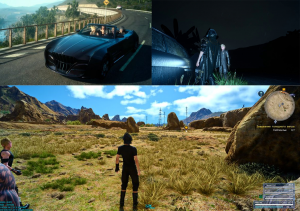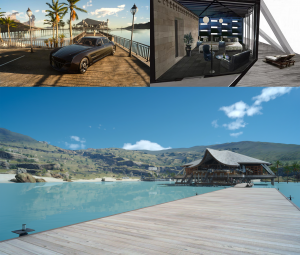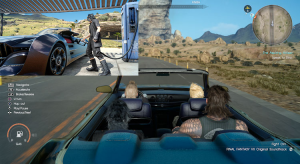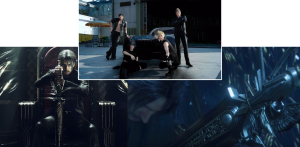
Introduction
Journey is an indie adventure game by Thatgamecompany and was published by Sony on March 2012. It is currently available for the Playstation 3, 4, and Microsoft Windows. The game was made on PhyreEngine and has won several “game of the year” awards and has also been listed as one of the greatest games of all time.
Journey is an adventure game featuring a mysterious red-cloaked character who explores the ruins of a of a lost civilization in a vast desert. The main goal of the game is the reach the peak of a distant mountain by passing several levels. The game also features a multiplayer mode in which players on the same level may assist each other but may not communicate via voice chat, text, or see each other’s game tags until after the end of the game. Instead, the only mode of communication is a musical chime.
Story
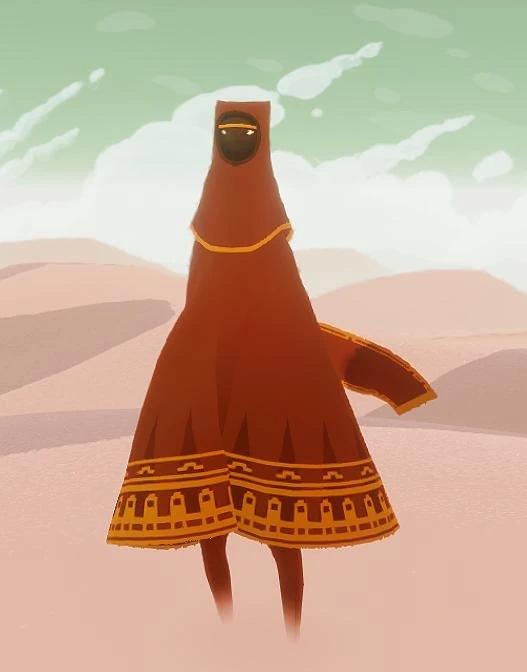
The main character
In Journey, the player must reach the peak of a distant mountain. Unlike other games, Journey‘s story is wordless and is only told through its gameplay, art, and cutscenes. The game explores the idea of the voyage of life and does so by contextualizing this voyage via the levels that lead up to the mountain. Each level is a representation of a part of life — the early levels are full of wonder, amazement, and discovery, symbolizing childhood. The later levels are filled with danger, anxiety, and act as a symbol of leaving childhood and into adulthood. The levels then become heavily focused on moving in an upward trajectory, indicating the quickening of time, closer to the end. As the player treks closer to the mountain, the slower the character grows before meeting death. After the ending credits, a shooting star shoots from the mountain and past the levels and back to the beginning where the player sees other robes characters heading toward the mountain.
Mechanics

 The main features of the game is exploration via walking or brief flying. The game’s character features a magical scarf that allows the player to fly temporarily and is recharged by walking or some other means. Touching other glowing symbols scattered throughout the game allows the player to extend the scarf, thus extending its flight life.
The main features of the game is exploration via walking or brief flying. The game’s character features a magical scarf that allows the player to fly temporarily and is recharged by walking or some other means. Touching other glowing symbols scattered throughout the game allows the player to extend the scarf, thus extending its flight life.
Its multiplayer features allows the play with one other stranger (whose username is unknown until after the game’s credits). Players can help each other by completing puzzles together but ultimately, two players are not needed to complete the levels.
Aesthetics

The game’s aesthetics is largely composed of flat colors, largely in a softer color palette (teals, pinks, gold, etc.) Its art is similar to cel-shading, where the shadows and highlights are flat colors rather than gradients.

Example of Journey’s use of lighting
Much of the game’s art and colors are meant to evoke some emotion in the player and does not focus its art on realism but rather on evoking the overall theme. One big part of the game is its use of light in its art. Rather than a means to mimic realism and make objects visible, light is used as a medium to create a mood or atmosphere in the game. According to the levels, whether it is the early levels filled with wonder or the later daunting levels, the color of light used is constantly different according to the ambience the game wants to create. Journey‘s use of luminosity to subtly reflect off the clouds of sand in the distant desert or dimly light up the underground level is one that leaves an impact on the player’s mood.

A more notable key factor of the game’s aesthetic is its use of simple and minimalistic design. There is little clutter throughout the game but instead emphasizes the idea of a vast, empty world. By doing this, the game puts its focus into creating scenes that look at the big picture rather than focusing on little details.
Technology
Journey runs on Playstation 3, 4, and Microsoft Windows. The game requires a minimum of Intel Core 2 Duo @ 2.4 Ghz, Windows 7+, Nvidia GeForce GTX 470, and 5 GB of space.
Lens 3: Fun
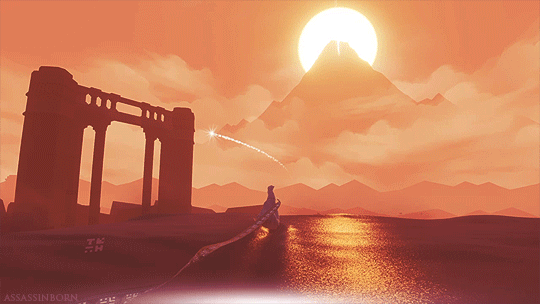
Every level, there is always something new that encounters the character or a new landscape that leaves the player in awe. The game is filled with fun things to do. Even when the player is not exploring some daunting level, there is always room to explore the landscape and discover new things.
Lens 4: Curiosity
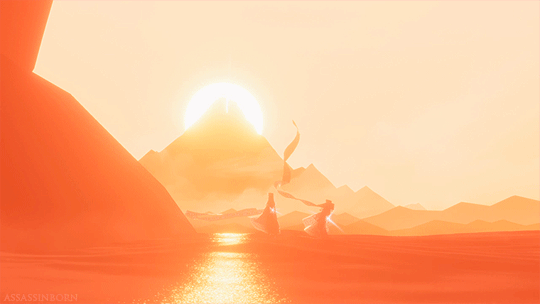
The main feature of the game is to evoke curiosity in the player. This is probably my favourite aspect in the game – how the game is elicit curiosity in players.
The biggest way Journey does this is by putting the player in a never-ending landscape with little explicit guidance. Instead, there are little floating red carpet-like creatures than implicitly guide the players, but the player is never required to follow them. Being in such a massive land, the player is pressed to explore beyond the required path.
Lens 6: Problem Solving
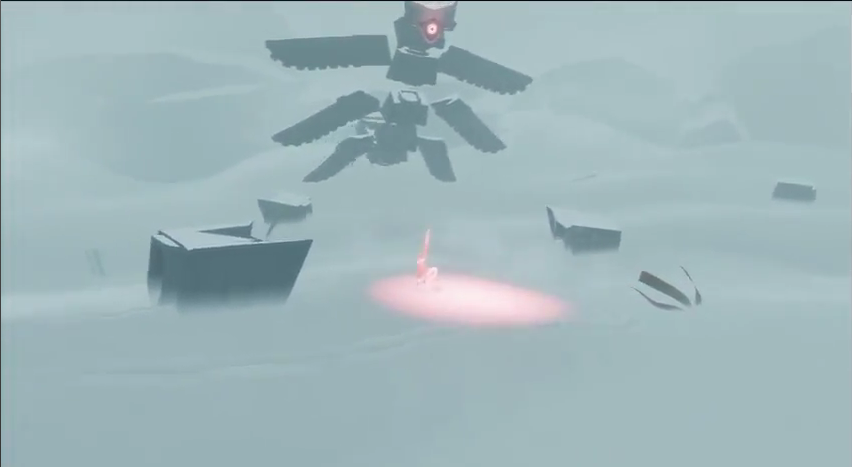 Every level has some sort of problem that the player must pass, whether it might be avoiding the Guardians (the enemies) or figuring out how to create a bridge between pillars. There is always some sort of puzzle to complete.
Every level has some sort of problem that the player must pass, whether it might be avoiding the Guardians (the enemies) or figuring out how to create a bridge between pillars. There is always some sort of puzzle to complete.
Lens 7: Emotion
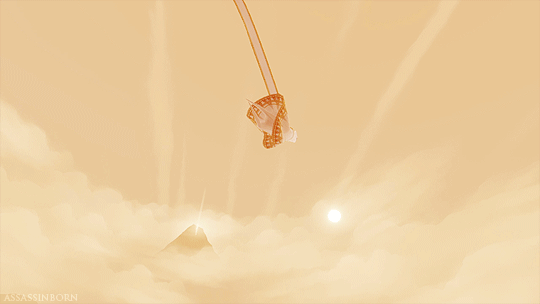
One of the characteristics of Journey that make the game such an impactful experience is its way of creating emotion. The game does so by emphasizing select features of a game – art and storyline. The storyline is simple – the circle of life from beginning to end. But what makes the story such a profound experience is its art. With its use of clever colors and simple design, Journey’s overall gameplay is one that is able to effortlessly set and change the ambience of the game.
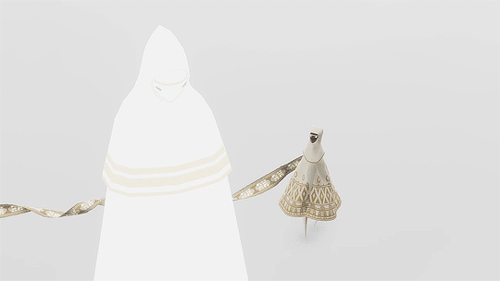 While most other games such as the Walking Dead, The Last of Us, etc. have strong storylines, the gameplay and the story is almost detached. Players don’t even need to play the game but instead simply watch a compilation of the cutscenes and still be able to feel emotion and grow attached to the protagonists. The gameplay in these games act as an additional support to make the stories interactive for players. In this sense, the two features are separate.
While most other games such as the Walking Dead, The Last of Us, etc. have strong storylines, the gameplay and the story is almost detached. Players don’t even need to play the game but instead simply watch a compilation of the cutscenes and still be able to feel emotion and grow attached to the protagonists. The gameplay in these games act as an additional support to make the stories interactive for players. In this sense, the two features are separate.
However, in Journey, gameplay and plotlines are intertwined together. One cannot work without the other. And this is done through its story told implicitly throughout the gameplay rather than cutting the story into cutscenes. The cutscenes in Journey, rather, are the supporting features but are not necessary in order to feel any attachment to the protagonist or to evoke emotion.
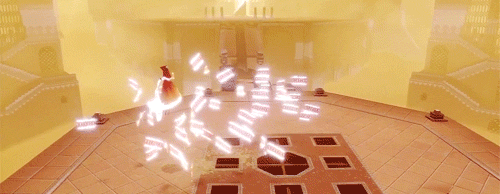
Overall, Journey is just an amazing and beautiful game. Highly recommend, 11/10.



